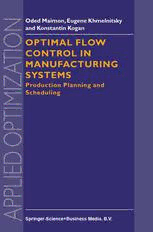Table Of ContentOptimal Flow Control in Manufacturing Systems
Applied Optimization
Volume 18
Series Editors:
Panos M. Pardalos
University 01 Florida, U.S.A.
Donald Hearn
University 01 Florida, U.S.A.
The titles published in this series are listed at the end 0/ this volume.
Optimal Flow Control
in Manufacturing Systems
Production Planning and Scheduling
by
OdedMaimon
Department ollndustrial Engineering,
Tel-Aviv University,
Tel-Aviv, Israel
Eugene Khmelnitsky
Department ollndustrial Engineering,
Tel-Aviv University,
Tel-Aviv, Israel
and
Konstantin Kogan
Department ollndustrial Engineering,
Tel-Aviv University,
Tel-Aviv, Israel
Springer-Science+Business Media, B.V.
A c.I.P. Catalogue record for this book is available from the Library of Congress.
ISBN 978-1-4419-4799-4 ISBN 978-1-4757-2834-7 (eBook)
DOI 10.1007/978-1-4757-2834-7
Printed on acid-free paper
Additional material to this book can be downloaded from http://extras.springer.com.
All Rights Reserved
© 1998 Springer Science+Business Media Dordrecht
Originally published by Kluwer Academic Publishers in 1998.
Softcover reprint ofthe hardcover 1st edition 1998
No part of the material protected by this copyright notice may be reproduced or
utilized in any form or by any means, electronic or mechanical,
including photocopying, recording or by any information storage and
retrieval system, without written permission from the copyright owner.
To our lamilies
When a ship does not arrive to a certain port
neither by due-date, nor later,
the Company's Boss exclaims: "The Devil !",
the Admiralty: "My God !"
(loosely translated from "New Jules Veme", a poem by Joseph Brodsky)
CONTENTS
Preface xv
PART I: BASIC CONCEPTS
CHAPTER 1. INTRODUCTION 3
1.1 Top-Down Production Planning Hierarchy 3
1.2 Planning and Scheduling Approaches 4
1.3 Why Specifically Optimal Control ? 6
1.3.1 Advantages 7
1.3.2 Limitations 7
1.4 Outline of the Book 8
Bibliography
CHAPTER2. MATHEMATICAL
FUNDAMENTALS OF OPTIMAL
CONTROL 11
2.1 Calculus ofVariations in Optimization Problems 11
2.1.1 Nature ofDynamic Systems 11
2.1.2 Modeling ofManufacturing Environment 12
2.1.3 Optimization of a Single-Time-Step Dynamic System 13
2.l.4 Optimization ofa Multi-Time-Step Dynamic System with Mixed
Controland State Variables Constraints 16
2.2 Maximum Principle Formulation for Optimal Control Problems 25
2.2.1 Statement of the Canonical Form of an Optimal Control Problem 26
2.2.2 Construction of aDescent Variation 28
2.2.3 Necessary Optimality Conditions 39
2.3 Maximum Principle-Based Numerical Methods 46
2.3.1 Shooting Method 47
2.3.2 Time-Decomposition Method 52
Bibliography
x
PART 11: FLOW CONTROL
IN PRODUCTION PLANNING
CHAPTER3. ONE-ITEM SINGLE-FACILITY
AGGREGATE PRODUCTION
PLANNING PROBLEMS 59
3.1 Introduction 59
3.2 Production Smoothing with Capacity Expansion 60
3.2.1 Problem Fonnulation 61
3.2.2 Analysis ofthe Optimal Production Plan 62
3.2.3 Analytical Rules for Managing Production Cases 66
3.2.4 Numerical Algorithm for Arbitrary Demands 68
3.3 Capacity Evolution Planning: Expansion, Deterioration and Selling 70
3.3.1 Problem Fonnulation 70
3.3.2 Analysis ofOptimal Production and Capacity Planning 72
3.3.3 Optimal Control Algorithm for Production and Capacity Planning 77
Bibliography
CHAPTER4. PRODUCTION PLANNING AT
DIFFERENT LEVELS OF
AGGREGATION 85
4. 1 Introduction 85
4.2 Balancing Facilities in a Make-To-Order Environment 86
4.2.1 Inventory Flow through Distributed Facilities 86
4.2.2 Numerical Algorithm for Balancing Facilities 89
4.3 Dispatching in a Make-To-Stock Environment 93
4.3.1 Dispatching Control Problem 93
4.3.2 Analysis ofthe Optimal Dispatching 94
4.3.3 Analytical Solution Algorithm 97
4.4 Draining Initial Inventories in a Delivery-To-Order Environment 98
4.4.1 Draining Control Problem 98
4.4.2 Optimal Draining 99
4.4.3 Numerical Algorithm for Draining 102
xi
4.5 Dynamic Job Assignment 105
4.5.1 Formulation ofthe Dynamic Assignment Problem 107
4.5.2 Optimal Assignment (production) Regimes 111
4.5.3 Dynamic Job Assignment Numerical Algorithm 113
Bibliography
PART 111: FLOW CONTROL
IN SCHEDULING
CHAPTER5. MODELING PRODUCTION
SYSTEMS WITH MULTI-LEVEL
BILLS OF MATERIALS 119
5.1 Introduction 119
5.1.1 Production Rate Control: Machine Loading and Setup Change 119
5.1. 2 Example of Controllable Production and Setup Rates 120
5.1.3 Known Approaches to Solving Scheduling Problems 120
5.2 Modeling Assumptions 124
5.3 Production Process with Bill ofMaterials 124
5.4 Setup Process 126
5.4.1 Negligible Setup Times 126
5.4.2 Significant Setup Times 126
5.4.3 Sequence-Dependent Setup Times 129
5.4.4 Special Case ofldentical Machines 130
5.5 Demand Profiles 132
5.5.1 Discrete Orders 133
5.5.2 Piece-wise Continuous Demand Flow 133
5.6 Types ofSubcontracting 133
5.7 Relevant Performance Measures 134
5.7.1 Cost ofProduction 134
5.7.2 Cost of Setup 135
5.7.3 Cost of Subcontracting and Purchasing 136
Bibliography
xii
CHAPTER6. NECESSARY OPTIMALITY
CONDITIONS FOR SCHEDULING
PROBLEMS 139
6.1 Introduction 139
6.2 Production Systems with Negligible Setup Times 140
6.2.1 Flexible Manufacturing Cells with Identical Machines 140
6.2.2 Individual Machines 149
6.3 Production Systems with Significant Setup Times 155
6.3.1 Single Machine 155
6.3.2 A Generalized Plant with Different Models for Setup Costs 167
6.4 Production Systems with Sequence-Dependent Setup Times 177
6.4.1 Partially Sequence-Dependent Setup Times 177
6.4.2 Flexible Cells with Identical Machines 181
6.4.3 Individual Machines 186
6.5 Case Study: Sikorsky Aircraft Corporation's Manufacturing Cell 200
Bibliography
CHAPTER 7. SOLUTION METHODS 207
7. 1 Introduction 207
7.2 Analytical Methods for Scheduling under Constant Demand 209
7.2.1 Limit Cycles 210
7.2.2 Switching Surfaces in State-Co-state Space 214
7.2.3 Approximation ofSwitching Surfaces 217
7.3 Numerical Methods for Scheduling with Negligible Setup Times 220
7.3.1 Straight-forward Time Decomposition 220
7.3.2 Combined Time Decomposition Method for Scheduling under
Piece-wise Constant Demand 222
7.3.3 Time Decomposition Method for Discrete Event Control ofIndividual
Machines 226
7.4 Numerical Methods for Scheduling with Significant and
Sequence-Dependent Setup Times 232
7.4.1 Shooting-based Scheduling Method 232
7.4.2 An Enhanced Modification to the General Shooting-based Method 234

